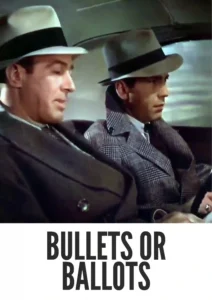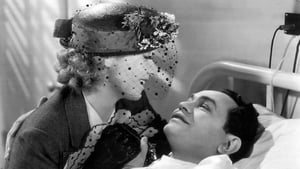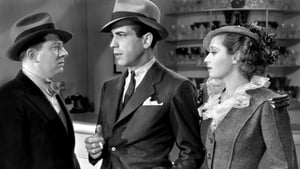Contact: info@alwanfilm.com
Video Sources 0 Views
- Watch trailer
- Bullets or Ballots


Synopsis
Table of Contents
ToggleReview: Bullets or Ballots 1936 Colorized – A Gripping Crime Drama in Vivid Color

Introduction
“Bullets or Ballots” (1936) takes audiences on a thrilling journey into the gritty underworld of organized crime and law enforcement. In this article, we’ll delve into the significance of this early colored film, exploring its impact on audiences and its enduring legacy in the realm of crime drama.
Check The Full Colorized Movies List
Check Our Colorized Movies Trailer Channel
Understanding Bullets or Ballots 1936 Colorized: Director, Cast, and Genre
Directed by the visionary William Keighley, “Bullets or Ballots” (1936) showcases his keen eye for detail and his ability to craft compelling narratives that keep viewers on the edge of their seats. The film boasts a talented cast, including Edward G. Robinson, Joan Blondell, and Barton MacLane, who deliver powerful performances that bring the world of organized crime to life. Blending elements of action, suspense, and intrigue, “Bullets or Ballots” (1936) immerses viewers in a world of danger and deception, where the line between right and wrong is blurred and the stakes couldn’t be higher.
Exploring the World of Bullets or Ballots 1936 Colorized: Plot and Characters
At its core, “Bullets or Ballots” (1936) follows the exploits of an undercover detective, played by Edward G. Robinson, who infiltrates a ruthless crime syndicate in order to bring its leaders to justice. Along the way, he forms an unlikely alliance with a streetwise con artist, portrayed by Joan Blondell, whose quick wit and resourcefulness prove invaluable in their quest to dismantle the criminal empire. As tensions rise and loyalties are tested, the stage is set for a showdown that will determine the fate of an entire city.
The Art of Film Colorization
Film colorization serves as a transformative tool that enhances the visual experience of classic movies, allowing viewers to immerse themselves in the rich tapestry of cinematic worlds. By adding color to black and white films, colorization breathes new life into familiar stories and captivates audiences with vibrant hues and striking visuals. In the case of “Bullets or Ballots” (1936), the decision to release the film in a colorized format offers viewers a fresh perspective on the timeless tale of crime and corruption, enhancing its immersive qualities and bringing its richly detailed world to life in vivid detail.
Early Colored Films: A Brief History
The history of colored films traces its roots back to the early days of cinema, with filmmakers experimenting with various techniques to add color to their creations. From hand-tinted frames to early Technicolor processes, the evolution of colored film has been marked by innovation and ingenuity, paving the way for the development of modern colorization techniques that continue to captivate audiences to this day.
Bullets or Ballots 1936 and Its Early Colored Version
The decision to release “Bullets or Ballots” (1936) in a colorized format was met with both excitement and apprehension. While some welcomed the opportunity to experience the film in vibrant color, others expressed concerns about the potential impact on its visual aesthetic. Nevertheless, the early colored version of “Bullets or Ballots” (1936) offers viewers a fresh perspective on the classic crime drama, enhancing its immersive qualities and captivating audiences with its stunning visuals and dynamic performances.
The Debate Over Film Colorization
The debate over film colorization continues to divide audiences and critics alike, with proponents praising its ability to breathe new life into classic movies and introduce them to a new generation of viewers, while detractors argue that it compromises the artistic integrity of the original work and diminishes its historical significance. As the debate rages on, filmmakers and audiences alike are left to ponder the merits and drawbacks of colorization in the ever-evolving landscape of cinema.
Examining Bullets or Ballots 1936 as an Early Colored Film
As with any colorized classic, the impact of colorization on “Bullets or Ballots” (1936) is a matter of personal interpretation. Some may argue that it enhances the film’s visual appeal and immerses viewers in its world, while others may feel that it detracts from the stark beauty of the original black and white version. Regardless of one’s stance on the issue, there’s no denying the enduring power of “Bullets or Ballots” (1936) as a gripping crime drama that continues to captivate audiences with its thrilling action, dynamic characters, and compelling storytelling.
Influence and Legacy: Bullets or Ballots 1936 Colorized’s Impact on Cinema
“Bullets or Ballots” (1936) has left an indelible mark on the world of cinema, inspiring countless filmmakers and captivating audiences with its timeless tale of crime and corruption. From its electrifying performances to its gritty realism, the film continues to resonate with viewers of all ages, reaffirming its status as a beloved classic of the crime drama genre.
Director’s Cinematic Legacy: Beyond Bullets or Ballots 1936 Colorized
William Keighley’s influence extends far beyond “Bullets or Ballots” (1936), with a diverse body of work that continues to captivate audiences around the globe. From his early days as a director at Warner Bros. to his later work in television, Keighley’s films are celebrated for their craftsmanship, integrity, and emotional depth. Through his groundbreaking work, Keighley has left an indelible imprint on the world of cinema, inspiring generations of filmmakers to follow in his footsteps.
Themes Explored in Bullets or Ballots 1936 Colorized
“Bullets or Ballots” (1936) explores a myriad of themes, from the corrupting influence of power to the redemptive power of justice. Through its richly drawn characters and complex plot, the film invites viewers to ponder the moral complexities of the criminal justice system and the eternal struggle between good and evil. As audiences immerse themselves in the world of “Bullets or Ballots” (1936), they are reminded of the universal truths that bind us together and the enduring power of courage, integrity, and redemption.
Reception and Controversy Surrounding Bullets or Ballots 1936 Colorized
Upon its release, “Bullets or Ballots” (1936) received widespread critical acclaim, with many praising its gripping narrative, dynamic performances, and realistic depiction of crime and corruption. However, the decision to release the film in a colorized format sparked debate among purists, reigniting the age-old discussion surrounding film preservation and artistic integrity. Despite the controversy, “Bullets or Ballots” (1936) remains a beloved classic that continues to resonate with audiences of all ages, reaffirming its status as a timeless masterpiece of the crime drama genre.
Where to Watch Bullets or Ballots 1936 Colorized Online
For those eager to experience the timeless magic of “Bullets or Ballots” (1936), the film is readily available on popular streaming platforms such as Netflix, Amazon Prime, and Hulu. Whether you choose to watch it in its original black and white format or the early colored version, “Bullets or Ballots” (1936) promises to transport you to a world of danger and intrigue, where the line between right and wrong is blurred and justice hangs in the balance.
FAQs About Bullets or Ballots 1936 Colorized
Q: Is “Bullets or Ballots” (1936) based on a true story? A: No, “Bullets or Ballots” (1936) is a work of fiction that draws inspiration from real-life events and experiences in the world of organized crime and law enforcement.
Q: Who are the main actors in “Bullets or Ballots” (1936)? A: “Bullets or Ballots” (1936) features an ensemble cast led by the talented Edward G. Robinson, Joan Blondell, and Barton MacLane, whose performances bring the film’s characters to life with intensity and authenticity.
Q: What awards did “Bullets or Ballots” (1936) win? A: While “Bullets or Ballots” (1936) did not win any major awards, it received critical acclaim for its gripping narrative, dynamic performances, and realistic depiction of crime and corruption.
Q: Why was “Bullets or Ballots” (1936) released in a colorized format? A: The decision to release “Bullets or Ballots” (1936) in color was made to introduce the film to a new generation of viewers and enhance its visual appeal for modern audiences. While the choice to colorize the film sparked debate among purists, it ultimately allowed “Bullets or Ballots” (1936) to reach a wider audience and ensure its continued relevance in the annals of cinematic history.
Conclusion
As we reflect on the enduring legacy of “Bullets or Ballots” (1936), let us celebrate its status as a timeless classic that continues to captivate audiences with its thrilling action, dynamic characters, and compelling storytelling. Whether viewed in its original black and white format or the early colored version, “Bullets or Ballots” (1936) remains a shining example of the power of cinema to entertain, inspire, and provoke thought.













